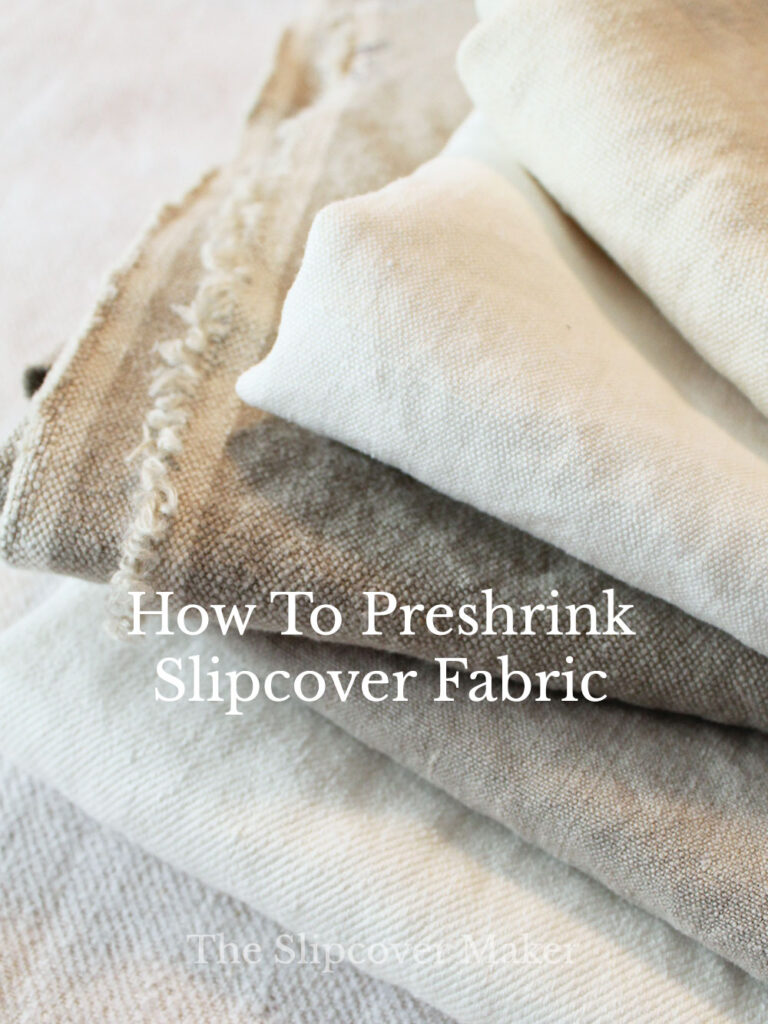How-To Preshrink Slipcover Fabric

Imagine making a slipcover (or having one custom made) and then the first time you wash it you can’t get it on your furniture because it shrunk. WHAT!!?
Yep, it’s a common scenario. And, once your slipcover shrinks there’s nothing you can do to restore the original fit.
That’s why if you want a washable slipcover that will maintain its fit, you must preshrink your slipcover yardage before you start your project.
Even fabrics labeled “laundered” or “preshrunk” will shrink. It’s misleading, I know.
Those labels only mean the yardage has undergone a finishing treatment that softened the hand-feel and drape. During that process, a tiny bit of shrinkage is removed but not enough to keep your slipcover from shrinking up so much you can’t use it.
To minimize shrinkage in 100% natural fiber fabrics and blends I recommend preshrinking your yardage by washing and drying it on hot. Read on to find out how I do it.
STEP 1: Cut yardage into 4 to 5 yard lengths. No need to serge or zigzag raw edges. Expect cut edges to ravel 1/2″ to 1″ on most cotton denim, canvas and linen fabrics. This is normal and will not interfere with the usability of your yardage.
STEP 2: Machine wash fabric in hot water, no detergent or softeners are needed. Wash (2) cut lengths per jumbo size washing machine at the laundromat. If you want to preshrink your yardage at home, wash only (1) cut length at a time and make sure your machine is large enough to allow the yardage to move about freely. Packing the yardage in too tight will cause deep set wrinkles.
STEP 3: Tumble dry on hot. Dry (1) cut length at a time. Drying time depends on type of fabric but 20 to 30 minutes is the norm. IMPORTANT: wet yardage quickly wads up into a ball after you start the dryer. Be sure to remove the fabric, unwind it and put it back in the dryer. Do this every 10 minutes. It’s a hassle but believe me this is the best way to minimize wrinkles.
STEP 4: Remove fabric from dryer promptly when dry. If you won’t be using your fabric right away, roll it on a cardboard tube rather than folding it. This will keep the fabric crease-free.
Pressing is optional. When I follow these preshrink instructions I never have to press yardage right out of the dryer. I might have to lightly press some of the cut pieces as I sew the slipcover but that’s it.
You can expect most natural fiber fabrics to come out of the dryer with a relaxed look, softened hand-feel and a low level of soft wrinkle (more like a crumple) that will flatten or fall out completely from handling the fabric. Some fabrics have a tendency to wrinkle more than others i.e. 100% cotton canvas wrinkles more than cotton denim.
If for some reason your preshrunk yardage has big, raised wrinkles that interfere with draping the fabric smoothly as you do your pin fitting you might want to press it flat before you start. I sometimes mist the fabric with water as I press.
Keep in mind, a natural fiber slipcover might have residual shrinkage even if you preshrunk the yardage. In an upcoming post I will share how I launder a slipcover to keep it looking and fitting its best.
Great info. I have one question. In Step 2, why do you say no detergents? I would want to use detergent to get any chemical smells out of the fabric.
Hi msmarigold! Laundry detergents and softeners don’t assist in the shrinking process at all. That’s why I wrote “no detergents, no softeners”. Hot water and agitation are what makes it happen (along with the hot tumble dry).
The hot water alone will remove some of the water soluble polymers used to create the starchy sizing applied to the fabric. FYI – When you don’t use a detergent in the preshrink you will see the water sudsy up…looks like soap but its the sizing starch that’s washing off. Well, at least some of it.
You can certainly use detergent in your preshrink. I don’t know of any detergent that will completely remove the chemical finishing from textiles. So many different chemicals are used in textile production in varying degrees and most of them are not meant to wash out. Chemical finishes will weaken over time with repeated washings, out gassing and abrading.
Thanks for the prompt reply and the detailed info. Your blog is such an inspiration to me. Soon I’m going to try to make my own slipcovers.